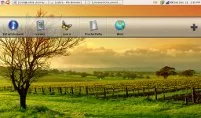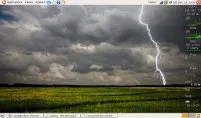Mini
Do you understand this netbook hype? You don't? You think every notebook should have an 18.4" screen and be able to display Crisis with at least 100 frames/s at a resolution of 1680x1050? Well, then you are unlike me and don't need to read further. 😉
I have to admit that I'm simply fascinated by these little things. I loved them from the very beginning, but what held me back initially was the low screen resolution which made horizontal scrolling necessary in the web. Now, that's really a nuisance, and put me off entirely.
After observing the market for a while, the following criteria for an attractive netbook formed:
- Intel graphics
- LED backlit display, non-glare
- highest resolution on smallest footprint (i.e., no 1024x600 on 10")
- maximum weight 1 kg (i.e., no 1.2 or 1.3 kg)
- no moving parts (i.e., no fans or HDs)
- no Windows (i.e., no Windows 😏)
- low price (€ 300 or below)
As if they'd known, Dell made an offer I just couldn't withstand: the Inspiron Mini 9.
- Atom N270 1.6 Ghz, 1 GB RAM
- Intel graphics
- LED backlit display, glare 😞
- 1024x600 on 8.9", i.e., a resolution of 133 dpi
- 1030 g
- fanless, 8 GB SSD
- Ubuntu 8.04
- 299 €
Almost a one-to-one correspondence, except for:
- the glare display
- the glossy black plastic which is euphemistically sold as "piano lacquer"
Well, I can live with that, giving the other merits of the Mini 9. So I gave in ... and ordered one 😮
It only took four days for my Mini to arrive in a neatly designed box. Except for the Mini itself, the box contains two CDs (one with Ubuntu 8.04 LTS and the other with Dell-specific software) as well as manuals on the hardware and on Ubuntu. Upon switching the Mini on, installation commences and asks for your name and location. After rebooting, the Mini comes up with its default desktop which you can see below on the left.
This default Dell desktop is thought to appeal to people having had little to no previous contact with computers. In the middle you see this desk after having clicked on the "Web" tab. Evidently, Dell and Yahoo have some kind of ... deal. Nevertheless, for a total newbie, this interface is nice and easy to use. In my opinion, Dell did a very good job with the design of their desktop.
For advanced users like ... öh ... me 😏, it's just one click to get rid of the Dell desktop. On the right side you see the standard Ubuntu desktop running Gnome 2.22 and another of the (truly pretty) backgrounds delivered by Dell. I've also installed gkrellm to assure you that the Atom processor indeed handles hyper-threading. As you see, it does.
Note that all these images appear about 40% too large when viewed on a standard desktop display. Typically, these displays have a resolution of about 95 dpi, while the Mini 9, as mentioned above, offers 133 dpi.


